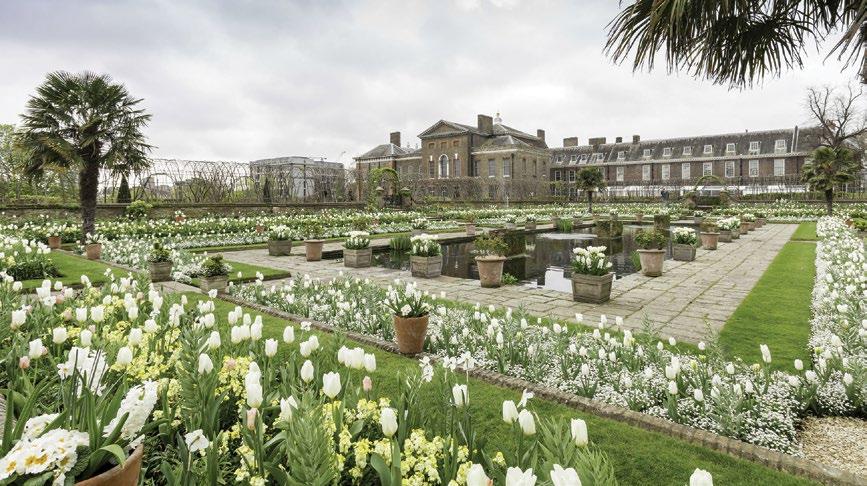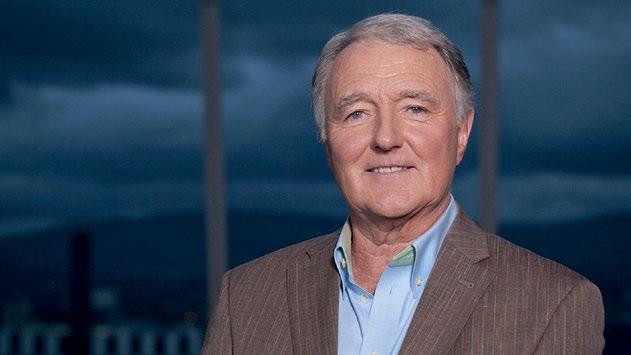
10 minute read
Princess Diana’s Legacy
How Diana helped open our doors to the British Royals
Princess Diana has been dead 20 years in August. In advance of the commemoration, Lorna Hogg traces the Princess’s lasting legacy and how she helped to change attitudes towards British Royalty in this country

Twenty years ago, on August 31st 1997, Diana, Princess of Wales died in car crash in Paris. It’s said that those whom the gods love die young. Diana was just 36 when she died; ‘The People’s Princess,’ loved by millions worldwide. They admired her style, beauty and her charitable work, which ranged from supporting those facing serious challenges such as AIDS and terminal illness, to working against land mines. All exemplify the style, interests and concerns of the Princess, and reflect the fact that Diana changed not just the role of Princess, but what we expect from royalty.
She had a powerful and lasting effect the British monarchy, in her lifetime, her legacy and through her sons. Future historians may debate her influence in changing the attitudes and perceptions of Irish people towards the British monarchy. Those changes may well have in turn helped towards the success of the Queen’s landmark visit to Ireland in 2012, and also the recent successful royal visits by Prince Charles and the Duchess of Cornwall across the island.
45 Senior Times l May - June 2020 l www.seniortimes.ie The Princess had personal Irish contacts. She was born with maternal connections through her wealthy and powerful Burke Roche family. She also forged more personal Irish links, from fashion to therapy and her personal staff. One of her favourite ‘go-to’ designers was Paul Costelloe,who designed for her throughout her royal life, including her ‘new look’ as an independent woman. From a sunny beach dress for Bondi beach on an Australian tour in 1988, to a 1991 rain soaked Pavarotti concert in Hyde Park, Costelloe’s designs matched the mood and provided some iconic pictures. The Princess also was close to Leitrim-born Oonagh Shanley Toffolo, her acupuncturist, and some claim, spiritual guide, in the period after her divorce, when she used alternative therapies to develop a new life for herself. Toffolo also introduced Diana to Hasnat Khan, with whom she became close after her marriage.
One of the princess’s closest advisers, Patrick Jephson, was born and attended school in Ireland, before studying at Cambridge and a career with the Royal Navy. He was her Private Secretary from 1988 – 1996, travelling the world with her and arranging her engagements and charity


Diana opens the Barnados facility in Belfast in 1986

The pink-peach rose Diana, Princess of Wales, one of hundreds of species named after Diana
work and was with the Princess during some of the most influential times of her life. Jephson she was on her staff when she recorded the infamous Panorama interview, and attempted to create a new life.
Diana also visited Northern Ireland on several occasions. Tight security during the 1980s and 1990s meant that there was no pre-visit publicity. However, the crowds still turned out, when on October 1985, the Princess arrived for a visit to the University of Ulster, and a Barnardo’s Nursery at Carrigafoyle, Belfast. To the initial concern of her security people, Diana broke with protocol and went over to greet the delighted crowds. With Prince Charles, she also went to Enniskillen in November 1987, after the Remembrance Day bombing. The royal couple visited hospitals, heard of the terrible injuries and attended funerals. Diana returned to Enniskillen in November 1993, to lay a weath on the war memorial and place the final stone on a Peace Cairn, which had been created by local children.
It was all very different from the formal and grand Royal visits to Ireland in the past. The royals were then a world away from life experiences of most Irish people – very few of whom ever met the royal guests on their visits. Queen Victoria drew large crowds, which (mostly) cheered from a distance. The same applied when King Edward VII and his beautiful Queen Alexandra, came over, as well as the last sovereigns to visit Ireland - King George V and Queen Mary, in 1911. Official royal visits then ceased.When Princess Margaret and her husband Lord Snowdon privately visited his relatives at Abbeyleix in 1962 a few press pictures were the result.
By the 1980s, the changed and extensive newspaper, magazine and television coverage allowed the world a glimpse of a new, young Royal superstar. The pretty and youthful new Princess of Wales had natural style, beauty and glamour, accompanied by informality, empathy and love of children This appealed to the Irish, as did her disregard for protocol and formality. Her determination to raise her children herself, rather than hand them over to nannies, and to teach them about life outside as well as inside palace walls also won hearts. Diana’s refusal to ‘put up and shut up’ during her well publicised marital problems also appealed to the Irish spirit. life with patients. She changed attitudes overnight by shaking hands with an AIDS sufferer in the 1980s, and supported AIDS charities. One young Irish sufferer at a London hospice told me after a visit by Diana that he didn’t know which had surprised him most – the fact that he had met a senior member of the British royal family, or the fact that she had made him laugh.
She visited the homeless, the terminally ill and those with disabilities. She campaigned for removal of landmines. She took her children to shelters for the homeless and to hospices. She was determined to ensure that her sons grew up with compassion, an understanding of and ease with the disabled and knowledge that not everyone was rich, had four holidays a year and Rolls Royces.
In 1995, Prince Charles made his first visit to Ireland. The Prince had long wanted to visit Ireland, and was probably prepared for almost any possibility during his three day trip. Except perhaps, the down to earth and direct curiosity of the Irish public about the females in his family. ‘And when is your mother coming over?’ was one of the first questions he faced . He was then asked how his estranged wife was. ‘Very well thank you,’ was the reply. ‘You let a good woman go, there.’ he was told. ‘Indeed I did,’ replied the Prince.
The visit was pronounced a success, and heralded others from other members of The Firm. Princess Anne, in her capacity in Riding for the Disabled, came over. So did the Duke of Edinburgh, in connection with the Duke of Edinburgh Award Scheme and its work with Gaisce, The Irish President’s Award. The Duchess of York, Prince Edward and Prince Andrew all made trips as well.
Diana’s death in 1997 was mourned worldwide. In London during the days before the funeral, Irish people were to be found in abundance. Many said that they felt that an affinity with Diana, and had to come over to mourn, some flying over especially. They swelled the crowd adding to the bank of flowers in front of her Kensington Palace home. They found vantage points in the crowds along the funeral route, and went to Hyde Park to watch the service on big screens. Inevitably, controversy arose when the Irish football team chose to sport black armbands in respect to the Princess, during an International game in Iceland in the days after the funeral. Criticism swiftly followed.
The Royal family also came under criticism at home, especially for sticking to established protocol over not flying the Royal Standard at half mast. As the sovereign’s flag, it can never fly at half mast – there is always a sovereign. The Queen finally proposed the idea that the Union Jack should fly at half mast over Buckingham Palace on the day of the funeral.
Over the next months, polls displayed perceptions and accusations that the royals were out of touch. They had to learn the lesson that Diana had changed the style and manner of being royal. Accessibility, walkabouts, ‘meet and greets’ empathy and the inclusivity of a wide range of society are now needed for modern Royal life. Duty, tradition and protocol remain important. However, today it is equally important to show warmth, compassion, the personal touch and responsiveness to modern life and ways.

ries and leading the country’s mourning. She also announced a minute’s silence in respect for the dead during her recent Official Birthday Parade, The Trooping of the Colour.
In 2012 the Queen and Prince Philip undertook one of the most significant visits of her reign – to Ireland. Initial tight security and polite wariness from the public during the politically sensitive engagements of the first two days gave way to increasing enthusiasm. The Queen (finally photographed smiling) encountered Irish enthusiasms, from hurling to Guinness and bloodstock. She learned about Irish food in the English Market in Cork, and revealed that she watched The X Factor on television. She met the crowds in Cork, and left the country with a hamper of Irish food - plus an invitation to William and Kate to visit Ireland and meet its young people.
William and Harry will, with Kate, continue Diana’s legacy. The Princes have an her ease of manner with all sections of society, and have continued their mother’s work, William with child bereavement, and the Tusk Trust for wildlife, Harry with her campaign against landmines in Angola. Harry has also formed Sentebale in his mother’s name, a charity which helps child victims of poverty and HIV/AIDS in Africa, and works with the Terence Higgins Trust. Both want to work with and encourage young people. This was reflected in the request by William and Kate to meet young people when they attended a Garden Party at Hillsborough Castle last summer.
Diana would be especially proud of her sons’ Heads Together Charity, formed with the Duchess of Cambridge, to encourage mental health, and start talking about emotional problems. Both Princes have revealed and related very personal experiences to publicise and inspire their causes. They also match words with actions - William was recently dubbed ‘Prince of Compassion’ for his comfort of Grenfell Tower victims on a recent visit with the Queen.
The Prince and Wales and the Duchess of Cornwall have made several very successful visits to both Northern Ireland and the Republic, meeting crowds now representing both political traditions. As Prince Philip cuts back on his workload, the younger royals will inevitably play a fuller part in The Royal Firm. Diana’s legacy is set to endure.
Diana remembered..


The Diana: Her Fashion Story exhibition at Kensington Palace tells the story of the evolution of Diana’s style. It includes a wide range of her gowns,a couple previously unseen, plus some iconic outfits, and sketches from fashion designers. The exhibition runs until February 2018. Visit www.hrp.org.uk for details of ticket availability, prices and phone booking.
The White Princess The Princess always admired the Sunken Garden in Kensington Palace, her London home, and over the past spring and this summer, a White Garden has been planted there to mark the twentieth anniversary of her death. White roses, set against foliage and grasses, cosmos daisies and gaura form the displays. www.hrp.org.uk
A lasting legacy Diana’s youthful home was Althorp, the stately home of the Spencer family in Northamptonshire, and the Princess is buried on a peaceful island on the lake at Althorp. This year, until October, visitors can view an exhibition of fifteen pictures of the Princess, taken by the top photographer, Mario Testino, a few months before her death. Amongst the last photographic sessions done by the Princess, the photographs are said by many to be amongst the finest ever taken of Diana. There is also an exhibition Walking in her Shoes , showcasing 20 exceptional holders of the Diana Award’s Legacy Award. www.spencerofalthorp.com Senior Times l May - June 2020 l www.seniortimes.ie 48










